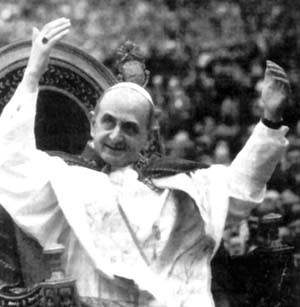 |
Book Reviews
The Sodomite Crisis in the Catholic Church
Fr. Stephen Somerville
Book-review on Vatican II, Homosexuality & Pedophilia by Atila S. Guimarães,
(Los Angeles: Tradition in Action, 2004), 315 pp.
Sodom was an ancient city, known to Abraham (see Gen 18…) and situated in a most fertile valley near the Dead Sea. Its people, the Sodomites, were well known for the practice of the worst unnatural vices including sodomy. This vice, we are told “cried out to Heaven” for vengeance. The vengeance came in fire and brimstone from Heaven, utterly destroying the city, which, it is thought, was later inundated and erased by the expansion of the Dead Sea. Abraham had pleaded with God to spare the city, for the sake of any good persons who still remained in it. But even ten were lacking. Only Lot, nephew of Abraham, and his small family could be claimed. The two angel visitors to Lot warned them to flee for their lives. A picture of this flight is the front cover of Atila Guimarães’ book on the current sodomite crisis in the Catholic Church. The title is Vatican II, Homosexuality & Pedophilia (henceforth HP).
Guimarães first treated this theme briefly as an appendix to his In the Murky Waters of Vatican II, Volume I of a serious study of Vatican Council II (1962-65) and its consequences. But the sodomite phenomenon ballooned with time and demanded a separate book. This is HP, 300 pages, with thorough footnotes, a six-page A-Z index and a compact style, allowing a wide-ranging treatment. (As I write this review, another study of sodomy in the Catholic Church is appearing, more than five times the size of HP).
The fact is that we have witnessed a sexual revolution. The present day ecclesiastical establishment is now officially tolerant of and merciful toward unchastity of all kinds. The official teaching documents still call it sin, or more mildly, disorder. But in practice, such sins are largely ignored; people – especially the young – tend not to confess them, and the Holy Communion lines have not been getting shorter. If we are not convinced by verbal arguments that the Vatican is losing the Faith, these facts remain undeniable and convincing.
What do Scriptures and Tradition say? The answer is stated in Chapter I of HP. Lest we imagine that sodomy is merely an Old Testament hang-up or bugaboo, we soon see that more than Abraham, Moses (Lev 18), and Isaiah (3:48) condemn the sin. In the New Testament, St. Paul (1 Cor, Rom), St Peter (2 Pet), and St. Jude ring firm with the same judgment. As for Tradition, a catalog of Saints, Popes, and Governors raise a chorus of detestation over homosexual sin. Punishment is severe: death, burning, life imprisonment, fasting permanently, degradation, and the like.
Chapter II of HP clarifies the new “conciliar” Vatican’s tolerance of immorality. This will definitely mean less or no Church punishment for sin. The new rules are an “adaptation” to secular thought, and show tolerance and mercy toward the evildoers. The author cites many Catholic authorities who are – in often vague or confusing language – embracing this moral revolution where bad becomes good and wrong becomes right.

Priests march to show solidarity with homosexuals in a parade in New York City |
An art critic once wrote a tactful review of a concert by a well connected but mediocre violinist. And so he resorted to “damning with faint praise.” I judge that today’s Church leaders are handling sexual abuse by praising with faint damn.
In Chapter III, the US Catholic scene is analyzed, citing the evidence of existing studies, authorities, Catholic associations, and their endless statistics. The sympathy of many US Bishops for homosexuals is manifest. It is not hard to conclude further that some of these clerics have their own homosexual partners, and even that the Vatican, before appointing them, knew of their homosexual condition (p. 101).
The author further investigates the now well-known existence of a homosexual “subculture” in US Catholic seminaries. This invasion of evil into the sanctuary is not only a guarantee of freedom to sin, but also a pressure on so-called straight seminarians to conform to the subculture and adopt this evil way of life. HP also reports a notable number of suicides by priests who had been accused of abuse. Are these accusations sometimes false? Rarely, it seems. One Catholic defense lawyer had worked in over 500 cases of alleged abuse. He believed that “fewer than ten priests” were falsely accused (p. 197).
Huge homosexual conventions under Catholic auspices are held from time to time. Bishops are often present. At one such event, a priest speaker concluded his talk with these absurd, outrageous and blasphemous words: “Jesus wants us to be erotically in love with him and that is not possible for homophobes” (p. 91).
How many priests are homosexual, actively or at least by inclination? HP reports various estimates of authorities: 20 %, 40 % (this in 1987), “22 to 58 percent”, “49% of priests and 55% of seminarians,” 80 percent (of one large religious order). As to how many priests have died of AIDs, one expert estimated 1,000 as of the mid-1990s (p. 114).
Should homosexual seminarians be ordained? Answers are variously accessed (see pp. 126-29 for the two extremes.) The author says a clear “no,” and urges the Vatican to issue a strong prohibition with “stern measures” and the teeth to enforce it in order to launch a “healing process” that will purify the international Catholic Church. We can only hope.

A credible case is established for the active personal homosexuality of Paul VI |
We travel around the world in Chapter IV and soon see that the sodomite scene is global. Unbelievably bold and false affirmations by Bishops and theologians concerning this immorality are found here and there. On pp. 157-62, a credible case is established for the active personal homosexuality of Pope Paul VI, and for his “appointment of homosexuals … close to the Papacy” (p. 161).
The author returns in Chapter V to the US, and pursues his survey under the category of pedophilia, this is, adult-to-child sexual abuse. In addition to all children age twelve and under, this group of victims could include younger teens and minors. The writer notes that the charge of pedophilia is more serious. It involves cowardice, cruelty, and usually abuse of trust in the case of priests, which is exclusively the case here. The great majority of victims are boys, not girls, and the older or the more developed be the adolescent boy, the more it becomes a case no longer of pedophilia, but of homosexual abuse. Scores of cases are reviewed, with names and places and details of charges. This chapter is a depressing read. It ends with estimates of the legal costs and settlements that Dioceses will have to pay. The total as of 2004 is placed at 3.19 billion, repeat billion, dollars.
In Chapter VI, the pedophilia disasters in other countries than the US are presented. On pp. 287-89, the techniques of cover-up, stalling, and so forth, by accused priests, by Bishops and by the Vatican are summarized. Guimarães remarks: “The Conciliar Church would indeed seem to be rotten from head to toe.”
A seven page “conclusion” is now presented, and frankly exposes the deliberate policy of tolerance and non-discipline that is promoting the destruction of the Catholic Church. And the root cause? “It is a titanic event. It is Vatican Council II.”
Then, two saints speak to us (pp. 294-97): Pope St. Leo IX and St. Peter Damian around 1050. The Pope warmly praises the hermit for his goodness and intelligence in promoting chastity and excoriating “that execrable vice,” which, it helps to know, was a problem in much earlier Catholic times and was attacked with great rigor. Then, St. Peter Damian’s searing tirade against the evils of sodomy follows.
Finally, to end his book, Author Guimarães spells out nine false positions (sophisms) employed to defend or to palliate the Catholic sodomite clergy, and he refutes each one. For example, sophism five holds that clerical celibacy is the cause of the problem. The reader can pursue these reassuring Catholic answers.
How do we face such a thorough, careful, balanced account of the ravages of clerical homosexuality and pedophilia throughout the Catholic Church? One is at least saddened and depressed, even if not outraged. How could things get so bad? Why is God’s grace not healing and remedying the situation? Why are we so helpless in the face of it all?
On the back cover of HP, the editor gives some brief, serious answers.
May all reading Catholics take time to acquire and read this excellent book.
This reviewer wishes to add a theological concern.
Jesus tells us, “Without Me you can do nothing.” The branch will not bear fruit if cut off from the vine. This means the grace of God is all important. We cannot become holy, or even avoid sinning for a long time, without sanctifying grace and actual grace from Christ. But grace has been cut off for many years now, since the 1960s, by the ousting of the old, reverent Latin traditional liturgy. The new liturgy, Novus Ordo, has been imposed and commanded. For many serious theological reasons, we fear that many of the Masses and ordinations and other Sacraments may well now be invalid, and consequently, not giving God’s grace to the recipients or to the priest.
Furthermore, the priest, permissive and tolerant of sin in himself as well as in his penitents (if he has any) is living without the grace of God and so conducting an unfruitful ministry. Standing and leering behind this scene is Satan, who is destroying the Church by the very obedience of Catholics to the ill-conceived liturgy of the post-conciliar Popes, especially Paul VI.
The solution for this unprecedented and manifold evil is very simple. It is a return to Catholic Tradition: the Mass, the Sacraments, reverence, chastity, modesty … Will this happen? In the larger scene, I fear not. The Vatican is not repentant, and only a great chastisement will bring it and the Bishops to their knees. In the smaller, local scene, yes. The healing has already come where small congregations and a few priests have re-embraced Catholic Tradition, especially the magnificent Latin Mass of all time. Yes, we suffer harassment, slander and dismissal from the deceived and progressivist Catholics. But we persevere and look forward to the period of peace promised by Our Lady of Fatima. And the life everlasting. Amen.

Posted July 6, 2006
|
More on
Vatican II, Homosexuality & Pedophilia
Book Reviews | Home | Books | CDs | Search | Contact Us | Donate

© 2002-
Tradition in Action, Inc. All Rights Reserved
|
 |

|